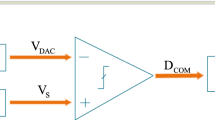Abstract
A low power analog to digital converter (ADC), based on a pipelining method employed in successive approximation register (SAR) architecture is presented. This structure is a two-stage pipeline SAR ADC with asymmetrical time interleaved (TI) channels, aimed to reach sampling rate as high as about threefold of a conventional SAR ADC while benefiting from its low power consumption and small area. Passive residue conversion without inter-stage amplifier and symphonic collaboration of stages are employed to design a low power, high speed, and accurate converter. In the proposed architecture, every signal sample experiences equal comparator offset during its conversion due to the applied novel operation sequence, without adding redundancy or comparator rotation scheme. A 7-bit ADC with sampling rate of 83 MS/s based on the proposed architecture is designed and its performance is verified by post layout simulation results in a 180-nm CMOS Technology. Both system level analysis and simulation verifications support proposed architecture superiority over similar reported SAR architectures.



















Similar content being viewed by others
References
Damghanian, M., & Shamsi, H. (2014). Combination of DAC switches and SAR logics in a 720 MS/s Low bit successive approximation ADC. Analog Integrated Circuits and Signal Processing, 80, 263–272.
Khoshakhlagh, M., & Yavari, M. (2013). An efficient threshold voltage generation for SAR ADCs. Mixed signal letters. Analog Integrated Circuits and Signal Processing, 75, 161–169.
Zhangming Zhu, Yu., Xiao, L. X., Ding, H., & Yang, Y. (2013). An 8/10 bit 200/100MS/s configurable asynchronous SAR ADC. Mixed signal letters. Analog Integrated Circuits and Signal Processing, 77, 249–255.
Liang, Y., Zhu, Z., & Ding, R. (2015). SAR ADC architecture with 98.8% reduction in switching energy over conventional scheme. Mixed signal letters. Analog Integrated Circuits and Signal Processing, 84, 89–96.
Kuppambatti, J., & Kinget, P. R. (2014). Current reference pre-charging techniques for low-power zero-crossing pipeline-SAR ADCs. IEEE Journal of Solid State Circuits, 49(3), 581–594.
Wu, J.-J., Chang, S.-J., Lin, S.-H., Huang, C.-P., & Huang, G.-Y. (2014). Low power pipelined SAR ADC with loading free architecture. IEEE, international symposium on VLSI design, automation and test (VLSI-DAT). doi:10.1109/VLSI-DAT.2014.6834906.
Huang, Y. C., & Lee, T. C. (2010). A 10b 100MS/s 4.5 mW pipelined ADC with a time sharing technique. ISSCC Dig. Tech. Papers. doi:10.1109/ISSCC.2010.5433927.
Wang, R., Chio, U.-F., Sin, S.-W., Seng-Pan, U., Wang, Z., & Martins, R. P. (2012). A 12-bit 110MS/s 4-stage single-opamp pipelined SAR ADC with ratio-based GEC technique. Proceedings of the ESSCIRC. doi: 10.1109/ESSCIRC.2012.6341336.
Jeon, Y.-D., Cho, Y.-K., Nam, J.-W., Kim, K.-D., Lee, W.-Y., Hong, K.-T., & Kwon, J.-K. (2010). A 9.15 mW 0.22 mm2 10b 204MS/s pipelined SAR ADC in 65 nm CMOS. Custom Integrated Circuits Conference (CICC). doi:10.1109/CICC.2010.5617457.
Jespers, P. G. A., et al. (1977). A fast sample and hold charge-sensing circuit for photodiode arrays. IEEE Journal of Solid-State Circuits. doi:10.1109/JSSC.1977.1050883.
Dolev, N., Kramer, M., & Murmann, B. (2013). A 12-bit, 200-MS/s, 11.5-mW pipeline ADC using a pulsed bucket brigade front-end. Symposium on VLSI circuits digest of technical papers, C98–C99.
Lin, C.-Y., & Lee, T.-C. (2014). A 12-bit 210-MS/s 5.3-mW pipelined-SAR ADC with a passive residue transfer technique. Symposium on VLSI circuits digest of technical papers. doi:10.1109/VLSIC.2014.6858452.
Lee, S., Chandrakasan, A. P., & Lee, H.-S. (2014). A 1GS/s 10b 18.9 mW time-interleaved SAR ADC with background timing-skew calibration. IEEE international solid-state circuits conference. doi:10.1109/ISSCC.2014.6757480.
Harpe, P., Busze, B., Philips, K., & de Groot, H. (2011). A 0.47-1.6mW 5bit 0.5-1GS/s time-interleaved SAR ADC for low-power UWB radios. IEEE Journal of Solid State Circuits, 47, 1594–1602.
Sin, S.-W., Ding, L., Zhu, Y., Wei, H.-G., Chan, C.-H., Chio, U-F., Seng-Pan, U., Martins, R. P., & Maloberti, F. (2010). An 11b 60MS/s 2.1 mW two-step time-interleaved SAR-ADC with reused S&H. IEEE Proceedings of the ESSCIRC. doi:10.1109/ESSCIRC.2010.5619890.
Ginsburg, B. P., & Chandrakasan, A. P. (2008). Highly interleaved 5-bit, 250-MSample/s, 1.2-mW ADC with redundant channels in 65-nm CMOS. IEEE Journal of Solid-State Circuits, 43(12), 2641–2650.
Sung, B. R. S., Cho, S.-H., Lee, C.-K., Kim, J.-I., & Ryu, S.-T. (2009). A time-interleaved flash-SAR architecture for high speed A/D conversion. IEEE international symposium on circuits and systems, ISCAS. doi:10.1109/ISCAS.2009.5117923.
Cho, Y.-K., Jung, J.-H., & Lee, K. C. (2012). A 9-bit 100-MS/s flash-SAR ADC without track-and-hold circuits. IEEE, international symposium on wireless communication systems. doi:10.1109/ISWCS.2012.6328494.
Gray, P. R., Hurst, P. J., Lewis, S. H., & Meyer, R. G. (2009). Analysis and design of analog integrated circuits (4th ed.). Wiley.
Saberi, M., Lotfi, R., Mafinezhad, K., & Serdijn, W. A. (2013). Analysis of power consumption and linearity in capacitive digital-to-analog converters used in successive approximation ADCs. IEEE Transaction on Circuits and Systems-I: Regular Papers, 58, 1736–1748.
Atkin, E., & Normanov, D. (2014). Area-efficient low-power 8-bit 20-MS/s SAR ADC in 0.18 μm CMOS. PROC. 29th international conference on microelectronics. doi:10.1109/MIEL.2014.6842188.
Zhu, Y., Chan, C.-H., Chio, U.-F., Sin, S.-W., Seng-Pan, U., Martins, R. P., & Maloberti, F. (2014). Split-SAR ADCs: Improved linearity with power and speed optimization. IEEE Transaction on Very Large Scale Integration (VLSI) Systems, 22(2), 372–383.
Rahman, L. F., Reaz, M. B. I., Yin, C. C., Ali, M. A. M. & Marufuzzaman, M. (2014). Design of high speed and low offset dynamic latch comparator in 0.18 µm CMOS Process. PLoS One, 9(10), e108634.
Meinerzhagen, P. (2008). Design of a 12-bit low-power SAR A/D converter for a neurochip. Master’s Thesis, University of California, Lausanne, August 15, 2008.
Zhang, D., Bhide, A., & Alvandpour, A. (2012). A 53-nW 9.1-ENOB 1-kS/s SAR ADC in 0.13-m CMOS for medical implant devices. IEEE Journal of Solid-State Circuits, 47(7), 1585–1593.
Li, Y., Zhang, Z., Chua, D., & Lian, Y. (2014). Placement for binary-weighted capacitor array in SAR ADC using multiple weighting methods. IEEE Transactions on Computer-Aided Design of Integrated Circuits and Systems, 33(9), 1277–1287.
Author information
Authors and Affiliations
Corresponding author
Rights and permissions
About this article
Cite this article
Fazel, Z., Saeedi, S. & Atarodi, M. Pipelining method for low-power and high-speed SAR ADC design. Analog Integr Circ Sig Process 87, 353–368 (2016). https://doi.org/10.1007/s10470-016-0736-y
Received:
Revised:
Accepted:
Published:
Issue Date:
DOI: https://doi.org/10.1007/s10470-016-0736-y




